Samsung UE60H6203AW, UE58J5205AK, UE58H5204AK, UE58H5203AW, UE55H6204AK Operating Instructions
...
E-MANUAL
Thank you for purchasing this Samsung product.
To receive more complete service, please register your product at
www.samsung.com/register
Model______________ Serial No.______________
Contents
Connecting Antenna and External devices
Connecting - Aerial
Video Device Connection
3Connecting - HDMI
4Connecting - Component
5Connecting - External Input
6Connecting - SCART
TV Audio through the External Speakers
8Connecting - Digital Audio (Optical)
9Connecting - Headphone
Connecting to a Computer
11Connecting - HDMI Port
12Connecting - HDMI (DVI) Port
13Connecting - Samsung Link
13 Connecting - Home Network (DLNA)
Connecting with a Mobile Device
15Mobile Device Screen on TV (Screen Mirroring)
16Connecting Mobile Devices without a Wireless Router (Wi-Fi Direct)
16Connecting - Samsung Link
17Connecting - Home Network (DLNA)
18Name of TV on Network
Input Signal Selection
Using Remote and Peripheral
Devices
Displaying the Remote Control on the Screen
Controlling External Devices with the TV Remote (Universal Remote Setup)
20Setting Up the Universal Remote Control
21Controlling External Devices with the TV Remote
Controlling the TV with a Keyboard
23 Connecting a Keyboard
23 Using the Keyboard
Controlling the TV with a Mouse
25Connecting a Mouse
26Using the Mouse
Entering Text Using QWERTY
27 Using Additional Functions
Internet Connection
Establishing a Wired Internet Connection
28Connecting a LAN Cable
29Connecting to a Wired Internet Network Automatically
29Connecting to a Wired Internet Network Manually
Establishing a Wireless Internet Connection
31Connecting to a Wireless Internet Network Automatically
32Connecting to a Wireless Internet Network Manually
33Connecting to a Wireless Internet Network with WPS
Troubleshooting Internet Connectivity Issues
34Troubleshooting Wired Internet Connectivity Issues
35Troubleshooting Wireless Internet Connectivity Issues
Mobile Network
36 Supported Telecom and Model Name
Checking the Internet Connection Status
Smart Features
Smart Hub
38Testing Smart Hub connections
39Opening the Home Screen
40Moving to the Panel Screen
40Using the Smart Hub Tutorial
40 Resetting Smart Hub
Using Smart Hub with Samsung Account
41 Creating a Samsung Account
43Signing into Samsung Account
44Linking My Samsung and App Accounts
45Changing and Adding Information to Samsung Account
45 Deleting All Samsung Accounts from the TV
Using SAMSUNG APPS Panel
47Using Pop-Up Menu Functions
48Installing an App
49Default Apps
49 Using Web Browser
52Rearranging Apps on the SAMSUNG APPS Screen
53Removing an App from the TV
53Rating/Reviewing an App
54Updating an App
54 SAMSUNG APPS Features
Using On TV Panel
58 Using Pop-Up Menu Functions
58Viewing Detailed Programme Information
59Configuring On TV Settings
Playing Photos, Videos, and Music (MULTIMEDIA)
60 Playing Media Content from a USB Device
61Playing Multimedia Content Saved in a Computer/Mobile Device
63Playing Photos
64Playing Videos
66Playing Music
67 Functions on the Media Content List Screen
TV Viewing Features
Digital Broadcast Information at a Glance
68Using the Guide
69Checking the Current Programme Info
69 Change the Broadcast Signal
69 Digital Signal Info and Strength
Setting Up a Schedule Viewing
70Setting Up Schedule Viewing
71Managing the Schedule Viewing List
Using the Channel List
Registering, Removing, and Editing Channels
73Registering and Removing Channels
73Editing Registered Channels
74Enabling/Disabling Password Protection on Channels
74Changing Numbers
74Locking/ Unlocking Channels
74Edit Channel Number
Creating a Personal Favourites List
75Registering a Channel as Favourites
76Viewing Favourites List Channels Only
76Editing a Favourites List
Adding Realism to Sports
79Enabling Football Mode
80Functions Available in Football Mode
TV-Viewing Support Features
81 Showing Subtitles
81Subtitle Options
82Changing Teletext Language
82Digital Text
83PIP Broadcast Viewing
84Scanning for Available Channels
85Selecting the Broadcast Audio Options
85 Audio Description
85 Genre Selection
85 Adult genre enabling
Using the Channel Settings
86Country (Area)
86Manual Tuning
87Fine-Tuning the Screen
88Transfer Channel List
88 Delete CAM Operator Profile
88 Satellite System
90 Common Interface
Picture and Sound Settings
Changing the Picture Mode and Adjusting the Picture
Quality
91Choosing the Right Picture Mode for the Viewing Environment
92Adjusting the Picture Quality for Each Picture Mode
93Fine-Tuning Each Picture Mode (Advanced Settings)
95 Adjusting the Picture for Easier Viewing (Picture Options)
Viewing in 3D
97Starting 3D
98Changing the 3D Mode
99Adjusting the 3D Effect
Picture Support Functions
100PIP Broadcast Viewing
101Changing the Picture Size and Position
102Listening to Audio Only with the Screen Turned Off
(Picture Off)
102 Resetting the Picture Mode Settings
Changing the Sound Mode and Using Sound Effects
103Choosing the Right Sound Mode for the Environment
104Using Sound Effects
Sound Support Functions
105 Selecting Speakers
105Designating the TV's Installation Type
105Enabling the Sound (Additional Settings)
106Listening to 3D Audio in 3D Mode
106 Resetting All Sound Settings
General
Setting the Time and Using the Timer
107Setting the Current Time
108Using the Timers
Using the Screen Burn Protection and Energy Saving
Features
110 Preventing Screen Burn
110 Using Energy Saving Features
Using the e-Manual
111 Launching the e-Manual
111Additional e-Manual Features
112Updating the e-Manual to the Latest Version
Updating the Software
113 Updating Software over the Internet
113Updating Software using a USB connection
114Enabling Automatic Software Updates
114 Software update via satellite channel
Protecting the TV from Hacking and malicious code
115 Checking the TV and Connected Storage Media
115 Automatically Scanning when the TV is Powered On
115 Automatically Adding malicious code to the Blocked List
Using Other Functions
116 Enabling the High Contrast
116 Adjusting the Menu Transparency
116 Expanding the Smart Hub's Focus Area
116Changing the Menu Language
117Checking Notifications
117Setting Up a Password
118Programme Rating Lock
118Enabling Game Mode
118Enjoying Rich Colours and Superior Picture Quality (BD Wise)
118Locking/Unlocking the Panel Keys
119Showing/Hiding the Samsung Logo while Booting
119Registering the TV as a DivX-Certified Device (Watching Paid DivX Movies)
120Restoring the TV to the Factory Settings
120 Turning the TV into a Display Model (for retail stores)
Connecting to a TV Viewing Card slot
121To connect the CI CARD, follow these steps:
122To connect the CI CARD Adapter, follow these steps:
Teletext Feature
Troubleshooting
Getting Support
126 Support through Remote Management
128 Finding the Information You Need for Service
There is a problem with the screen
128 Testing the Picture
I can't hear the sound clearly
131 Testing the Sound
I can't see 3D images clearly.
132 Testing 3D Picture Quality
There is a problem with the broadcast.
The computer won't connect.
I can't connect to the Internet.
I am having trouble launching/using apps.
My file won't play.
I want to reset the TV.
Other Issues
Notes and Precautions
Read Before Using 3D Viewing Mode
137 3D Precautions
140 Supported Resolutions for each 3D Mode
Read Before Using SAMSUNG APPS
Web Browser Restrictions
Photo, Video, and Music File Limitations
145Storage Device File Transfers
146Supported External Subtitles
146Supported Internal Subtitles
147Supported Image Formats and Resolutions
147Supported Music Formats and Codecs
148Supported Video Codecs
Restrictions
150 Restrictions to PIP (Picture-in-Picture)
Read After Installing the TV
151 Picture Sizes and Input Signals
151Installing an Anti-Theft Kensington Lock
152Read Before Setting Up a Wireless Internet Connection
Computer Connection Precautions
153 IBM
153MAC
154VESA DMT
155LED 4 series
155 IBM
155MAC
156VESA DMT
Supported Video Resolutions
Licence
Glossary

Connecting - Aerial
"Availability depends on the specific model and area.
Before connecting any external devices and cables to the TV, first verify the model number. A sticker containing the model number is attached to the back of the TV. The connection method varies depending on the model.
An aerial must be connected to the TV in order to receive broadcast signals.
"An aerial connection is not necessary when a cable box or satellite receiver is used.
Connect the correct aerial cable according to your viewing environment to the TV's aerial connector, as shown in the diagram.
It is best to connect the both connectors using a Multi-Switch or Diseqc. Switch, etc and to set Aerial Connection Type to Dual.
"Availability depends on the specific model and area.
Video Device Connection
"" Availability depends on the specific model and area.
Your TV has a variety of connectors for video input from external devices such as cable boxes, satellite receivers, Blu-ray players, DVD players, camcorders, and gaming consoles. Below is a list of featured connectors shown in descending order of picture quality.
●● HDMI
●● Component
●● External Input
Connect a video device to the TV via an HDMI connector for the best picture quality. If the device does not have an HDMI connector, try a component connector to get the next best picture quality.
"" The number of connectors and their names and locations may vary depending on the model.
"" Refer to the external device's operating manual when connecting it to the TV. The number of external device connectors and their names and locations may vary depending on the manufacturer.
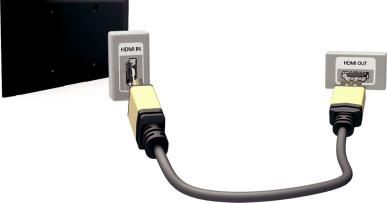
Connecting - HDMI
Before connecting any external device or cable to the TV, first verify the TV's model number. A sticker containing the model number is attached to the back of the TV. The connection method varies depending on the model.
The following types of HDMI cables are recommended:
●High-Speed HDMI Cable
●High-Speed HDMI Cable with Ethernet HDMI cables have certain requirements:
"Use an HDMI cable with a thickness of 14 mm or less.
"Using a non-certified HDMI cable may result in a blank screen or a connection error.
"Some HDMI cables and devices may not be compatible with the TV due to different HDMI specifications.
"This TV does not support HDMI Ethernet Channel. Ethernet is a LAN (Local Area Network) built with coaxial cables standardised by the IEEE.
Refer to the diagram and connect the HDMI cable to the video device's HDMI output connector and the TV's HDMI input connector.
"The number of connectors and their names and locations may vary depending on the model.
Once the connection has been made, you will be able to select the connected external device using the SOURCE button.
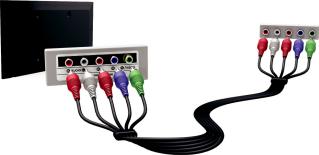
Connecting - Component
Before connecting any external devices and cables to the TV, first verify the model number of the TV you purchased. A sticker containing the model number is attached to the back of the TV. The connection method varies depending on the model.
Refer to the diagram and connect the Component cable to the TV's component input connectors and the device's component output connectors.
Make sure the cable colours match the connector colours.
Once the connection has been made, you will be able to select the connected external device using the SOURCE button.

Connecting - External Input
Before connecting any external device or cable to the TV, first verify the TV's model number. A sticker containing the model number is attached to the back of the TV. The connection method varies depending on the model.
Refer to the diagram and connect the AV cable to the TV's AV input connectors and the device's AV output connectors.
If you are using the TV's AV input connectors, connect the video cable to the Y connector. Some models feature a video connector as well. In this case, connect the cable to the video connector.
Once the connection has been made, you will be able to select the connected external device using the SOURCE button.
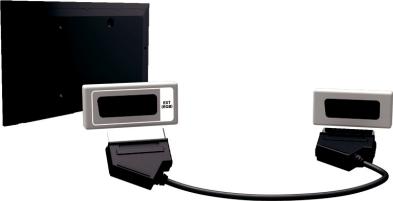
Connecting - SCART
"Availability depends on the specific model and area.
Before connecting any external devices and cables to the TV, first verify the model number of the TV you purchased. A sticker containing the model number is attached to the back of the TV. The connection method varies depending on the model.
Connect the TV’s SCART input connector to the device’s SCART output connector using a SCART cable. An extra audio connection is not needed because SCART also carries audio.
"SCART can only carry standard-definition video.
TV Audio through the External Speakers
Your TV has a variety of connectors for audio input from devices such as Blu-ray players and DVD players and for audio output to such devices as amplifiers. The connectors are listed below.
●● Digital Audio (Optical)
There are several issues to bear in mind when using audio input:
●● For better audio quality, it is a good idea to use an AV receiver.
●● The number of connectors and their names and locations may vary depending on the model.
●● Refer to the external device's operating manual when connecting it to the TV. The number of external device connectors and their names and locations may vary depending on the manufacturer.
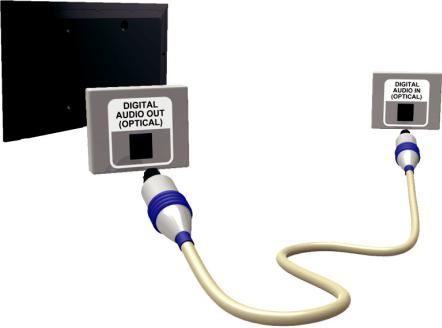
Connecting - Digital Audio (Optical)
"Availability depends on the specific model and area.
Before connecting any external device or cable to the TV, first verify the TV's model number. A sticker showing the model number is attached to the back of the TV. The connection method varies depending on the model.
Connecting an AV receiver to the TV via a digital audio (optical) connector lets you listen to digital audio.
Connecting a device using an optical cable does not automatically turn off the TV speakers. To turn off the TV's speakers, set TV Sound Output (Sound > Speaker Settings > TV Sound Output) to something other than TV Speaker.
Adjust the audio device's volume using its remote control.
"An unusual noise coming from the audio device while you are using it may indicate a problem with the audio device itself. If this occurs, ask for assistance from the audio device manufacturer.
"Digital audio is only available with 5.1-channel broadcasts.
Refer to the diagram and connect the optical cable to the TV's digital audio output connector and the device's digital audio input connector.
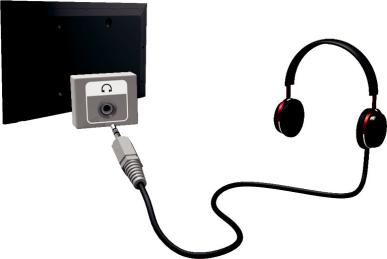
Connecting - Headphone
"Availability depends on the specific model and area.
Before connecting any external device or cable to the TV, first verify the TV's model number. A sticker containing the model number is attached to the back of the TV. The connection method varies depending on the model.
Refer to the diagram and connect the headphones to the headphone output connector. Only use headphones with a 3-conductor TRS type jack. The headphone volume and the TV volume are adjusted independently of each other. While the headphone is connected, the TV speakers are muted and certain Sound options are deactivated.
"The connectors may not be supported depending on the model.
Connecting to a Computer
You can directly connect a computer to the TV or to the network to view the computer screen or content on the TV. Connect the computer to the TV as follows.
●● Connecting via HDMI Port
You can connect the computer to the TV using the HDMI cable to display the computer screen on the TV.
●● Connecting with the HDMI (DVI) Port
You can connect a computer to the TV by connecting the computer's DVI port to the TV's HDMI port with the DVI to HDMI cable to display the computer screen on the TV.
●● Connecting via Samsung Link
Quickly access the photo, video and music files saved on a computer on which Samsung Link software is installed, even if you do not connect the TV directly to the computer.
●● Connecting via Home Network (DLNA)
Quickly access the photo, video and music files saved on a computer by connecting the TV and the computer to the same router or AP.

Connecting - HDMI Port
Before connecting any external device or cable to the TV, first verify the TV's model number. A sticker showing the model number is attached to the back of the TV. The connection method varies depending on the model.
For HDMI connection, one of the following HDMI cable types is recommended:
●High-Speed HDMI Cable
●High-Speed HDMI Cable with Ethernet
"Use an HDMI cable with a thickness of 14 mm or less. Using a non-certified HDMI cable may result in a blank screen or a connection error.
"Some HDMI cables and devices may not be compatible with the TV due to different HDMI specifications.
"This TV does not support HDMI Ethernet Channel. Ethernet is a LAN (Local Area Network) built on coaxial cables standardised by the IEEE.
"Some computers do not support HDMI interface, depending on its graphics adapter specifications. In this case, use a DVI-to-HDMI cable to connect the computer to the TV.
Refer to the diagram and connect the HDMI cable to the external video device's HDMI output connector and the TV's HDMI input connector.
Once the connection has been made, you will be able to select the connected external device using the SOURCE button.

Connecting - HDMI (DVI) Port
If the graphics adapter of your computer does not support HDMI interface, connect the computer to the TV with the DVI (Digital Visual Interactive) to HDMI cable. However, DVI-to-HDMI connection is supported by the HDMI port for DVI only and does not support audio signal transmission. To listen to the computer sound, connect the external speaker to the computer's audio output connector.
"For information on resolutions supported by the TV, refer to "Computer Connection Precautions".
Refer to the diagram and connect the DVI-to-HDMI cable to the TV's HDMI (DVI) port and the computer's DVI output port.
Once the connection has been made, you will be able to select the connected external device using the SOURCE button.
Connecting - Samsung Link
Quickly access photo, video and music files saved on a computer with Samsung Link software installed. Also, use Samsung Link to play and view the content of a computer that has been registered to Samsung Link under your Samsung account, even if the computer and the TV are not connected to the same router or AP.
111Visit the Samsung content and service portal (http://link.samsung.com) on a computer and sign into your Samsung account.
"" To install Samsung Link desktop software, you will need to first sign into your Samsung account. If you don't have a Samsung account, create one first.
222Install Samsung Link desktop software. When the installation is complete, the computer will be registered to Samsung Link.
333Specify the folder you wish to link to the TV. You can view and play photo, video and music files contained in the specified folder on the TV screen.
"" For more information on using Samsung Link desktop software, refer to the software's Help section.
Connecting - Home Network (DLNA)
Quickly access and view/play photo, video and music files from a computer on the TV screen.
111Connect the TV and the computer to the same router or AP. A home network will be configured once the two connections are established.
"" Home Network (DLNA) enables content-sharing between the TV, computers and mobile devices connected to the same wired or wireless router.
222From the computer, select [Control Panel] > [Network and Internet] > [Network and Sharing Centre] > [Change advanced sharing settings] and select [Choose media streaming options...] to activate media streaming.
333 From the list, set TV to [Allowed].
444Launch Windows Media Player from the computer, select [Settings] > [Library Management] and then add the location where the photo, video and music files are saved to view/play the files on the TV screen.
"" It will be possible to view/play on the screen files moved to Windows Media Player's default folder.
"" As long as File Sharing is activated, unauthorised access may be allowed. Disable File Sharing if data access is not required.
Connecting with a Mobile Device
Connect mobile device such as a smartphone or tablet to the TV directly or indirectly over a shared network and display the mobile device screen or content on the TV screen. Connect the mobile device to the TV as follows.
●● Mobile Device Screen on TV (Screen Mirroring)
Wirelessly connect the TV to the mobile device with the mirroring function to view the mobile device's screen on the TV.
"" This option is available only with mobile devices that support mirroring.
●● Connecting Mobile Devices without a Wireless Router (Wi-Fi Direct)
Wi-Fi Direct enables you to connect the TV to a mobile device without a router or AP. Quickly access and play photo, video and music files from a connected mobile device on the TV screen.
"" This option is available only with mobile devices that support Wi-Fi Direct.
●● Connecting via Samsung Link
Samsung Link enables you to play photo, video and music files from a Samsung Link-enabled mobile device without having to manually connect the device to the TV.
●● Connecting via Home Network (DLNA)
View/play on the TV photo, video and music files from a mobile device connected to the same router or AP as the TV.

Mobile Device Screen on TV (Screen Mirroring)
"" Availability depends on the specific model and area.
Network > Screen Mirroring Try Now
Wirelessly connect a mirroring-enabled mobile device to the TV and play the video and audio files stored on the device on the TV. Mirroring refers to the function that plays the video and audio files located on a mobile device on a TV and on the mobile device simultaneously.
"" To use the Screen Mirroring function, the mobile device must support a mirroring function such as AllShare Cast or Screen Mirroring. To check whether your mobile device supports the mirroring function, please visit the mobile device manufacturer's website.
"" The video or audio may intermittently stop depending on network conditions.
Connecting via a mobile device
111On the mobile device, run Screen Mirroring. The mobile device searches for available devices to connect to.
222 From the search result list, select TV. The TV displays a pop-up window.
333 In the pop-up window, select Allow to connect the mobile device.
"" All previously allowed mobile devices will automatically connect without needing approval.
"" If you select Deny, the device won't appear and can't be activated in this way. Navigate to Network > Screen Mirroring > Device Manager to allow the previously denied mobile device.
Not searching for the TV on mobile devices...
111Navigate to Network > Screen Mirroring to run Screen Mirroring. Also, you can select Screen Mirroring on a list by pressing SOURCE.
222Run mirroring on the mobile device. Display a list while automatically searching for mobile devices.
333 Select the TV and it connects automatically.
"" When the mobile devices cannot connect, try turning the TV off and on.
Allow/Reject the connection via mobile devices
"" This is only available for watching when mobile devices allow the connection.
111Navigate to Network > Screen Mirroring > Device Manager to activate Device Manager. This displays a list of required mobile devices connection.
222 You can allow access or deny connections with mobile devices.

Connecting Mobile Devices without a Wireless Router (Wi-Fi Direct)
Network > Wi-Fi Direct Try Now
Wi-Fi Direct lets you connect mobile devices directly to your TV using wireless technology. After connecting a device to the TV using Wi-Fi Direct, it will be possible to view/play video, photo, and music files from the device on the TV.
"" The mobile device must support Wi-Fi Direct. Make sure the mobile device you intend to use supports Wi-Fi
Direct.
111Enable Wi-Fi Direct on the mobile device and then launch Wi-Fi Direct. The TV automatically scans for and displays a list of available devices. The TV's name also appears on the mobile device.
222Select the device from the list to initiate a connection. If a connection request is made by the TV, a permission message appears on the mobile device and vice versa.
333 Allow the connection. This completes the connection process.
Connecting - Samsung Link
Samsung Link enables you to view/play photo, video and music files from a Samsung Link-enabled mobile device with ease. Also use Samsung Link to play and view the content of a mobile device that has been registered to Samsung Link under your Samsung account, even if the mobile device and the TV are not connected to the same router or AP.
111 Run the Samsung Link app on the mobile device and then sign in with your Samsung account.
"" To use Samsung Link, you have to sign in with a Samsung account. If you don't have a Samsung account, create one first.
222Quickly access and play photo, video and music files from the mobile device running Samsung Link app under your Samsung account.
"" For more information on using the Samsung Link app, refer to the Help section of the manual.
Connecting - Home Network (DLNA)
View/play photo, video and music files from a mobile device on the TV.
111Connect both the TV and the mobile device to the same router or AP. A home network will be configured once the connections are established.
"" Home Network (DLNA) enables content-sharing between the TV, computers and mobile devices connected to the same wired or wireless router.
222Enable File Sharing on the mobile device. The mobile device's shared content can be viewed/ played on the TV.
"" As long as File Sharing is activated, unauthorised access may be allowed. Disable File Sharing if data access is not required.

Name of TV on Network
Network > Device Name Try Now
Choose or enter a TV name to be displayed on the network.
111 Select Device Name from the Network menu. A list will appear.
222Choose a name from the list. Alternatively, select User Input to enter a name manually. You can view the specified TV name on the network.
Input Signal Selection
You can select a connected external device using the SOURCE button.
For example, to switch to a gaming console connected to the second HDMI connector, press SOURCE. From the Source list, select HDMI2 to change the input signal to HDMI mode. Connector names may vary depending on the model.
The following options are available in the Source screen:
●● TOOLS Button
Select a port connected to an external device, and press and hold the Enter button. The following functions are available:
""
––
Available options for each connector may vary.
Edit Name: Rename devices connected to the TV for easier identification of external sources. For example, you can designate a computer connected to the TV via an HDMI-DVI cable as DVI PC. Alternatively, simply designate a computer connected to the TV via an HDMI cable as PC. You can also designate an AV device connected to the TV via an HDMI-DVI cable as DVI Devices.
–– Information: View detailed information about the connected devices.
–– Disconnect USB Device: Used to safely remove a USB device connected to the TV.
"" This option is only available when a USB device has been selected.
●● Universal remote setup
Select Universal remote setup on the screen to configure the universal remote function. By configuring a universal remote control, you can control cable boxes, Blu-ray players, home theatres, and other external devices using a single remote control.
"" Availability depends on the specific model and area.

Displaying the Remote Control on the Screen
Press the KEYPAD button to display the virtual remote control on the screen. You can easily enter digits, control content, and use TV buttons with the virtual remote control.
"" The virtual remote control buttons may vary depending on the TV's current status.
Button |
Description |
|
|
|
|
Web Browser |
Launch the Web Browser. |
|
|
|
|
PIP |
Display the video from an external device or computer on the main screen and the |
|
TV as a picture-in-picture. |
||
|
||
|
|
|
P.Mode |
Lets you select the Picture Mode. |
|
""Availability depends on the specific model and area. |
||
|
||
|
|
|
Speaker Settings |
Select the speakers which you want to use to listen to the TV's sound. To set this |
|
option, external speakers must be connected to the TV. |
||
|
||
|
|
|
Schedule Manager |
Move to the Schedule Manager screen. |
|
""Availability depends on the specific model and area. |
||
|
||
|
|
|
3D |
Turn the 3D effect on or off. |
|
""Availability depends on the specific model and area. |
||
|
||
|
|
|
Media Play |
Run the Media Play. Lets you play media content saved on USB devices. |
|
|
|
|
MENU |
Displays the menu on the screen. |
|
|
|
|
e-Manual |
Launch the e-Manual. |
|
|
|

Controlling External Devices with the TV Remote
(Universal Remote Setup)
System > Universal Remote Setup Try Now
"Availability depends on the specific model and area.
The universal remote control feature lets you control cable boxes, Blu-ray players, home theatres, and other external devices connected to the TV using the TV's remote control. In order to use the TV's remote control as a universal remote, you must first connect the IR extender cable (included).
"Certain external devices connected to the TV may not support the universal remote feature.
Setting Up the Universal Remote Control
Before connecting any external devices and cables to the TV, first verify the model number of the purchased TV. A sticker containing the model number is attached to the back of the TV. The connection method varies depending on the model.
To use the TV remote as a universal remote, connect the IR extender cable (included) to the TV and position it within 10 cm of the external device's remote control receiver.
"The colour and design of the IR extender cable may vary depending on the model.
"When you connect the cable, you have to match the cable’s colour and socket’s colour.
Connect the IR extender cable to the TV's IR output connector as shown in the diagram and place the transmitter end within 10 cm of the external device's receiver pointing in the direction of the remote receiver. However, there must be no obstacles between the IR extender cable and the external device. The presence of obstacles interferes with the transmission of the remote control signal.
Controlling External Devices with the TV Remote
External Device Registration
11Turn on the external device to set up the universal remote function for, and bring up the Source screen.
21Select  Universal remote setup from the top of the screen. This initiates the universal remote setup process.
Universal remote setup from the top of the screen. This initiates the universal remote setup process.
31 Follow the on-screen instructions and register the external device.
Using the TV Remote
Registering an external device to the TV remote also registers the connector through which the device is connected. Accordingly, simply selecting the external device using the SOURCE button makes it possible to control the device using the TV's remote.
Universal Remote Features
11 Press SOURCE to bring up the Source screen.
21Select  Universal remote setup from the top of the screen. This initiates the universal remote setup process.
Universal remote setup from the top of the screen. This initiates the universal remote setup process.
31Select an external registered device on the Universal remote setup screen. The following options are available:
●Use External Speakers
Listen to the audio from the external device through the connected home theater.
"This is available only on the set-top box or Blu-ray player.
●Link Set-top Box
Listen to the audio from the set-top box through the home theater that is connected to the TV.
"This is available only on the home theater system.
●Link Blu-ray Player
Listen to the audio from the Blu-ray player through the home theater that is connected to the TV.
"This is available only on the home theater system.
●Source Setup
Change the TV's input source to your selected external device.
●Sync with TV power
Configure the set-top box to turn off when the TV is turned off
"This is available only on the set-top box.
●Rename
Rename the registered external device (up to 15 characters long)
●Delete
Remove the registered external device.

Controlling the TV with a Keyboard
System > Device Manager > Keyboard Settings Try Now
You can use a keyboard to control the TV.
"Certain models do not support USB HID class keyboards.
Connecting a Keyboard
Connecting a USB Keyboard
Plug the keyboard cable into the TV's USB port. A connection message appears on the screen.
Using the Keyboard
Use the following remote features with the USB keyboard connected to the TV.
●Arrow Keys (moving the focus), Windows Key (MENU Button), Menu List Key (TOOLS Button), Enter Key (Select/run item), ESC (RETURN Button), Number Keys (Number Buttons)
●F1 (a), F2 (b), F3 ({), F4 (}), F5 ( ), F6 (SOURCE Button), F7 (CH.LIST Button), F8 (MUTE Button), F9/F10 (Volume Buttons), F11 / F12 (Channel Buttons)
), F6 (SOURCE Button), F7 (CH.LIST Button), F8 (MUTE Button), F9/F10 (Volume Buttons), F11 / F12 (Channel Buttons)
●Page Up/Page Down: Scroll web browser pages up/down.
●Holding down the Enter key: On the Smart Hub screen, navigate to an item and hold down the Enter key to display the Options menu.
"The Options menu depends on the context.

Changing Keyboards Try Now
"" Availability depends on the specific model and area.
Select System > Device Manager > Keyboard Settings > Select Keyboard. Designate which keyboard to use.
"" Only one keyboard can be used at a time.
Input Languages, Keyboard Type, and Switch Language Key Try Now
Select System > Device Manager > Keyboard Settings > Keyboard Options. The following options are available:
●● Keyboard Language
If the keyboard supports multiple languages, choose which language you want to use from the list.
●● Keyboard type
Specify the type of language selected under Keyboard Language.
"" The Keyboard type list varies depending on which language was selected under Keyboard Language.
●● Switch Input Language
If the keyboard supports multiple languages, choose from the list which key to use to switch between languages.

Controlling the TV with a Mouse
System > Device Manager > Mouse Settings Try Now
This TV can be operated with ease using a mouse instead of a remote control.
"" Certain models do not support USB HID class mice.
Connecting a Mouse
Connecting a USB Mouse
Plug the mouse cable into the TV's USB port. A connection message appears on the screen.
